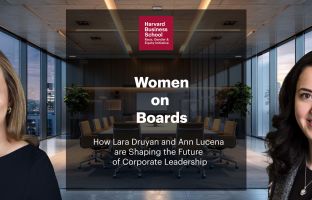Cheryl Beninga waved her cell phone to sum up the impact she’s had as a board member and investor in the technology world. The GPS on that phone? She helped make that possible. The gaming? Check. The Bluetooth? That too.
Beninga was in the marketing department at Intel Corp. in the late 1990s when she realized her product was headed for trouble. The company didn’t have the graphics capability that her overdrive upgrade processor needed. Pinpointing the problem was easier than persuading someone to listen. Eventually, she said, Intel realized that the problem affected not only her product but also the entire company, and they dispatched her to buy a graphics company. Then, Intel’s investment team snapped her up.
Her persistence was part of her style of “advocating for the right business thing,” as she describes it.
Before long, Beninga was sitting on six private company boards that Intel had invested in. (She has lost track of how many boards she has served on over the years.)
On private company boards, where she has spent her recent career, advocating is important, but so is listening. Private company board members too often think of their own firm’’s investment in the new company instead of what’s right for that company, Beninga said. She picks carefully the private companies on whose boards she will sit and looks for entrepreneurs who want her to be part of a board that’s more than “window decoration.”
Paying it forward to help female entrepreneurs
Since leaving Intel, Beninga has spent the past 10 years supporting technology start-ups run by women, as an investor and board member and though the accelerator FourthWave Foundation, which she cofounded. Her own company, Wai Mohala Ventures, is named after a flower that blooms through water. “It’s the growth and blooming of new companies, new technologies and the entrepreneurs we work with,” she said.
“I spent my whole career being the only woman in the room. It’s lonely,” said Beninga, 62.
She sees great strides for women in technology: The current 300 women-led venture funds compares with only 30 in 2010, she said. Larger funds are adding more women as partners. Women are securing more venture capital investments. Although women-only teams attract a mere 2% of venture dollars, she noted, mixed-gender leadership teams get about 20% of the funding.
Antoinette Banks is one of Beninga’s protégés. Banks’ start-up, Expert IEP, is an application that will help families develop education plans for their children with special needs. Banks was drawn to FourthWave Foundation by a video that highlighted Beninga’s attitude of seeing openings instead of hurdles. Now, Beninga is a confidant who can always provide valuable insight.
Beninga also is a person who supports Banks “showing up” as herself — a Black and Hispanic woman with a feminine style of dress who might need to take time off to help her autistic daughter.
Banks compares Beninga to a walk on the beach in a nice breeze but with solid sand underfoot. She is “someone who is light-hearted and very kind but also unmoving in her expectations and the foundation she sets,” said Banks, who won the $1 million top prize from the nonprofit Black Ambition, funded by singer Pharrell Williams.
In addition, Beninga sits on boards of women-led start-ups that focus on health, including Ananya (creating cervical cancer treatment equipment), and De Oro (developing a device that uses visual and audio cues to help people with Parkinson’s disease walk and remain independent).
“It’s a good feeling to know that your work is impacting lives, hopefully for the better,” Beninga said.
Fresh ideas from women-led ventures
Focusing on women-led companies is not just about equality, Beninga said. Women bring different perspectives and ideas for products targeted at women in the consumer, technology, and health markets.[1] [2]
“There’s so much money to be made in these overlooked segments. If we’re not investing in the things women are bringing forward, we are missing huge improvements in our world,” she said. “We have structural bias in the venture world. The capital flows to the same firms even though the higher returns are with diverse new managers.”







